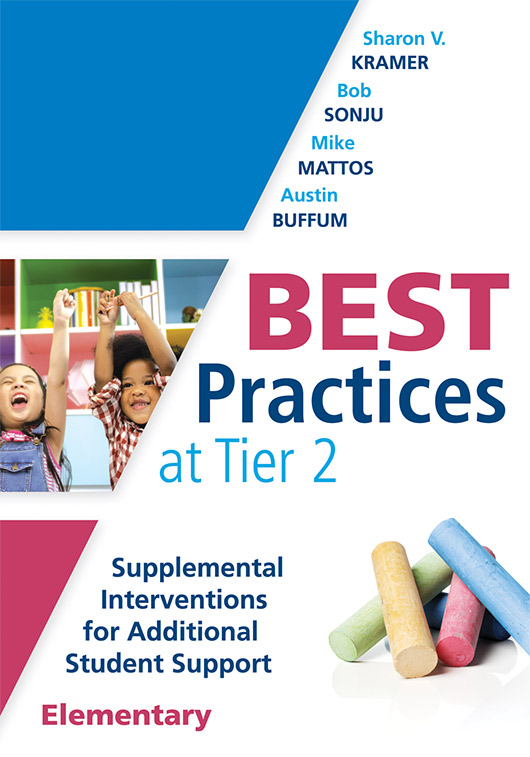Free Reproducibles
Best Practices at Tier 2
Supplemental Interventions for Additional Student Support, Elementary
Move away from the way we have always done things and embrace an improved approach to student intervention. At Tier 2 of the RTI at Work™ process, interventions do not require hiring additional staff, buying more resources, or extending the school day. Instead, this book offers a step-by-step process for how to use your current time and resources to ensure all students learn at high levels.
Benefits
- Receive proven, practical strategies and tools for creating Tier 2 interventions.
- Discover the foundational principles of effective educational practices.
- Understand the roles of teacher, leadership, and intervention teams in the response to intervention (RTI) system.
- Gain tips and best practices for determining student learning levels and how to move student learning forward.
- Review structures and schedules that build time in the school day to support students who need interventions in an elementary education setting.
Table of Contents
Chapter 1: Making a Case for Doing Things DifferentlyChapter 2: Using Collaborative Teams for Effective Intervention
Chapter 3: Getting to Targeted and Specific Interventions
Chapter 4: Using Data to Target Tier 2 Interventions
Chapter 5: Implementing Powerful Instructional Supports
Chapter 6: Building Time in the Schedule for Additional Support
Epilogue
REPRODUCIBLES
- Chapter 1: Key Considerations Rubric
- Chapter 2: Key Considerations Rubric
- Chapter 3: Key Considerations Rubric
- Chapter 4: Key Considerations Rubric
- Chapter 5: Key Considerations Rubric
- Chapter 6: Key Considerations Rubric
- Figure 6.2: Panorama Elementary Data Meeting Protocol
- Figure 6.3: Intervention Team Questions
SUGGESTED RESOURCES
Books
- Buffum, A., Mattos, M., & Malone, J. (2018). Taking Action: A Handbook for RTI at Work. Bloomington, IN: Solution Tree Press.
- Buffum, A., Mattos, M., & Weber, C. (2009). Pyramid Response to Intervention: RTI, Professional Learning Communities, and How to Respond When Kids Don't Learn. Bloomington, IN: Solution Tree Press.
- Buffum, A., Mattos, M., & Weber, C. (2012). Simplifying Response to Intervention: Four Essential Guiding Principles. Bloomington, IN: Solution Tree Press.
- Conzemius, A. E., & O’Neill, J. (2013). Handbook for SMART School Teams: Revitalizing Best Practices for Collaboration (2nd ed.). Bloomington, IN: Solution Tree Press.
- DuFour, R., DuFour, R., Eaker, R., Many, T. W., & Mattos, M. (2016). Learning by Doing: A Handbook for Professional Learning Communities at Work (3rd ed.). Bloomington, IN: Solution Tree Press.
- DuFour, R., & Eaker, R. (1998). Professional Learning Communities at Work: Best Practices for Enhancing Student Achievement. Bloomington, IN: Solution Tree Press.
- DuFour, R., & Marzano, R. J. (2011). Leaders of Learning: How District, School, and Classroom Leaders Improve Student Achievement. Bloomington, IN: Solution Tree Press.
- Guskey, T. R. (Ed.). (2009). The Teacher as Assessment Leader. Bloomington, IN: Solution Tree Press.
- Kramer, S. V., & Schuhl, S. (2017). School Improvement for All: A How-To Guide for Doing the Right Work. Bloomington, IN: Solution Tree Press.
- Marzano, R. J. (2009). Formative Assessment and Standards-Based Grading. Bloomington, IN: Marzano Resources.
- Marzano, R. J. (2017). The New Art and Science of Teaching. Bloomington, IN: Solution Tree Press.
- Mattos, M., DuFour, R., DuFour, R., Eaker, R., & Many, T. W. (2016). Concise Answers to Frequently Asked Questions about Professional Learning Communities at Work. Bloomington, IN: Solution Tree Press.
- Reeves, D. (2016). FAST Grading: A Guide to Implementing Best Practices. Bloomington, IN: Solution Tree Press.
- Sonju, B., Kramer, S. V., Mattos, M., & Buffum, A. (2019). Best Practices at Tier 2, Secondary: Supplemental Interventions for Additional Student Support. Bloomington, IN: Solution Tree Press.
- Vagle, N. D. (2015). Design in Five: Essential Phases to Create Engaging Assessment Practice. Bloomington, IN: Solution Tree Press.
- Wiliam, D. (2018). Embedded Formative Assessment (2nd ed.). Bloomington, IN: Solution Tree Press.

